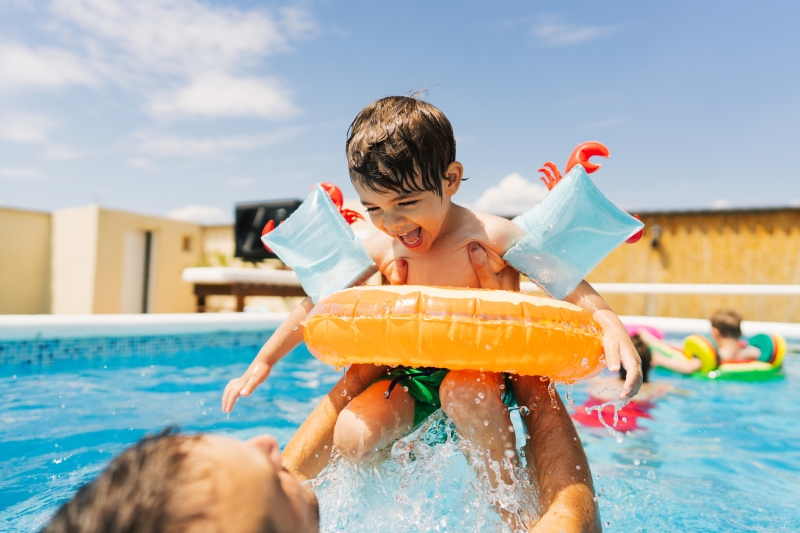Swim Safety for Children: Essential Tips Every Parent Should Know
June 27, 2025
When the weather warms up, many families head to pools, lakes, or beaches to cool off and have fun. Swimming is a great way for children to stay active and build confidence in the water. But it’s also important to remember that the water can be dangerous, especially for children who don’t yet know how to swim or understand the risks.
Drowning is one of the leading causes of accidental death in children under the age of 14. Most of these tragedies happen quickly and quietly, often when an adult isn’t watching closely or when a child slips into the water unnoticed. The good news is that most water-related injuries and deaths are preventable. With the right preparation, education, and supervision, parents can help ensure their children stay safe while enjoying time in and around the water.
First rule of water safety is supervision
The single most important rule when it comes to swim safety is supervision. No matter a child’s age or skill level, an attentive adult should always be watching them while they’re in or near water.
Designate one adult as the “water watcher,” someone who isn’t looking at their phone, reading a book, or multitasking. This is especially important at gatherings where it’s easy to assume someone else is keeping an eye on the children. Take shifts if needed, and make it clear who is responsible at all times.
Even if lifeguards are present, parents should still keep close watch. Drowning can happen in seconds and is often silent, without splashing or cries for help.
Teach safety skills and enroll in swim lessons
Swimming lessons are one of the most effective ways to protect children from drowning. The American Academy of Pediatrics recommends swim lessons for most children starting around age 1, depending on their development and comfort in the water.
Look for certified programs through organizations like the American Red Cross or YMCA. Early lessons typically focus on water safety, floating, breath control, and safe ways to enter and exit the pool. As children progress, they’ll learn basic strokes and how to tread water.
Alongside lessons, teach children basic water rules from a young age:
- Always ask an adult before going in the water.
- Never swim alone.
- No running or roughhousing near the pool.
- Swim parallel to the beach
- Check the temperature and depth before diving in
- Avoid swimming if red flags are up by a lifeguard
- Understand the concepts of currents and under toe
- Stay away from pool drains and covers.
Using simple language and repetition helps reinforce these messages. Roleplay or safety-themed games can also make learning fun and memorable.
Even strong swimmers need to follow water safety rules. Accidents can happen to anyone, and rules help prevent risky behavior.
Create a safe home pool environment
If you have a pool at home, it's essential to make the environment as safe as possible. Many accidents happen in backyard pools when adults believe the area is secure, but children are naturally curious and quick to act.
Install a four-sided fence that’s at least four feet high, with a self-closing, self-latching gate. Keep pool toys out of the water when they’re not in use so children aren’t tempted to reach for them.
Consider installing pool alarms, door alarms, or surface wave detectors that alert you if someone enters the water unexpectedly. Always cover the pool when not in use with a safety-approved cover, not just a soft tarp, which can collapse under weight.
Finally, establish clear rules for your home pool and enforce them consistently.
Use safety gear but don’t rely on it alone
Floaties and inflatable toys may look cute, but they aren’t reliable for safety. Only use U.S. Coast Guard-approved life jackets, especially for young or inexperienced swimmers.
Children should wear life jackets around open water, on boats, or when near docks. These jackets are designed to keep the head above water and help a child stay afloat even if they’re tired or unconscious.
Never rely on floatation devices as a substitute for supervision or swim skills. Water wings, pool noodles, and inner tubes can slip off, flip over, or give a false sense of security.
When choosing a life jacket, make sure it fits snugly and is appropriate for your child’s size and weight. Check the label to ensure it’s approved for swimming and boating use.
Know the signs of secondary drowning and when to act
While rare, secondary drowning (also known as delayed drowning) and dry drowning can happen after a child has a near-drowning experience or inhales water. These conditions can occur hours after the initial incident, which is why it’s important to watch your child closely even after they seem fine.
Warning signs include:
- Persistent coughing
- Labored or fast breathing
- Chest pain
- Extreme fatigue or changes in behavior
- Vomiting
If your child exhibits any of these symptoms after being in the water, seek medical attention immediately. It’s always better to be cautious when it comes to water-related breathing issues.
Emergency preparedness for parents and caregivers
Preparation can make all the difference in an emergency. All parents and caregivers should know how to respond to a water-related incident and that starts with learning CPR.
Consider taking a certified CPR and first aid course through the American Heart Association or Red Cross. Many communities also offer pediatric-specific courses that focus on infant and child resuscitation.
Keep a phone nearby any time children are swimming so you can call 911 immediately if needed. It’s also a good idea to have a basic rescue plan in place. Know how to safely reach or throw a flotation device to a child without putting yourself at risk.
If you’re hosting a pool party or gathering, assign one adult as the “designated responder” who knows CPR and is prepared to act if needed.
